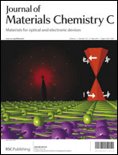
Journal of Materials Chemistry C
Scope & Guideline
Pioneering Research for Tomorrow's Materials
Introduction
Aims and Scopes
- Optoelectronic Materials:
Research focused on the design, synthesis, and application of materials for optoelectronic devices, including organic light-emitting diodes (OLEDs), photodetectors, and solar cells. - Energy Conversion and Storage:
Studies on materials that facilitate energy conversion processes, such as photovoltaics, photocatalysis, and batteries, with an emphasis on enhancing efficiency and stability. - Nanomaterials and Nanostructures:
Exploration of nanostructured materials, including quantum dots, nanosheets, and nanocomposites, for advanced applications in electronics and photonics. - Hybrid Organic-Inorganic Systems:
Investigations into hybrid materials that combine organic and inorganic components to leverage the advantages of both for improved optoelectronic and energy-related functionalities. - Sensing Technologies:
Development of materials and devices for sensing applications, with a focus on chemical and biological sensing through innovative luminescent and electrochemical strategies. - Theoretical and Computational Materials Science:
Utilization of computational methods to predict and elucidate the properties of materials, guiding experimental research and material design.
Trending and Emerging
- Aggregation-Induced Emission (AIE) Materials:
There is a growing trend towards the development of AIE materials for applications in organic light-emitting diodes (OLEDs) and sensors, highlighting their potential for high efficiency and stability. - Sustainable and Eco-Friendly Materials:
Research focusing on environmentally friendly materials, including lead-free perovskites and biodegradable polymers, is on the rise, driven by the need for sustainable technologies. - 2D Materials and Heterostructures:
The exploration of two-dimensional materials, particularly their integration into heterostructures for advanced electronic applications, is gaining momentum, reflecting their unique properties. - Machine Learning in Materials Science:
The application of machine learning techniques to predict material properties and optimize synthesis processes is emerging, showcasing the intersection of computational science and materials research. - Flexible and Wearable Electronics:
There is increasing interest in the development of flexible and wearable electronic devices, driven by advancements in materials that combine conductivity, flexibility, and functionality. - Photonic Applications of Materials:
Research on materials used in photonic applications, such as sensors and communication devices, is expanding, particularly in the context of enhancing performance and integrating functionalities.
Declining or Waning
- Traditional Inorganic Semiconductors:
Research papers focusing solely on conventional inorganic semiconductors have decreased, possibly due to the increasing interest in hybrid and organic materials that offer better performance and lower environmental impact. - Low-Dimensional Materials Without Functionalization:
Studies on low-dimensional materials such as graphene or transition metal dichalcogenides without significant functionalization or application development are less prominent, as researchers now prioritize functionalized materials with specific applications. - Static Photonic Crystals:
The interest in static photonic crystal structures is waning in favor of dynamic and tunable systems that can adapt to external stimuli, reflecting a trend towards smarter materials. - Basic Characterization Studies:
Papers that focus primarily on the characterization of materials without further applications or innovative approaches are becoming less common, as researchers seek to connect their findings to practical applications.
Similar Journals
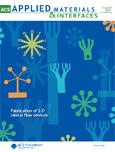
ACS Applied Materials & Interfaces
Unleashing the Potential of Interdisciplinary ResearchACS Applied Materials & Interfaces, published by the American Chemical Society, stands as a leading journal in the field of applied materials, nanotechnology, and interdisciplinary research in medicine. With an impressive Impact Factor that places it in the Q1 category across Materials Science, Medicine, and Nanoscience and Nanotechnology, this journal consistently ranks among the top tier, evidencing its significance and influence in advancing scientific knowledge. The journal’s scopus ranking of 33 out of 463 in General Materials Science further underscores its critical role in disseminating innovative and high-quality research. Although it is not an open-access journal, a diverse range of access options is available, ensuring that vital research findings are accessible to a broad audience of researchers, professionals, and students. Targeting breakthroughs in the synthesis, characterization, and application of materials and interfaces, ACS Applied Materials & Interfaces serves as a pivotal platform for publishing cutting-edge studies essential for future technological advancements.

SmartMat
Exploring New Frontiers in Material Mechanics.SmartMat is a cutting-edge, peer-reviewed academic journal published by WILEY, dedicated to the fields of Chemistry, Materials Science, and Mechanics of Materials. Launched in 2020, this Open Access journal aims to disseminate high-quality research and innovative findings that bridge these interdisciplinary areas. With an impressive impact factor reflecting its strong scholarly influence, SmartMat currently holds the prestigious Q1 category ranking in key domains such as Chemistry (miscellaneous), Materials Science (miscellaneous), and Mechanics of Materials, underscoring its relevance and importance in advancing material research. The journal is ranked among the top in its fields on Scopus, with 98th and 97th percentiles for Engineering and Chemistry rankings, respectively. Researchers, professionals, and students looking for a platform to share advancements in smart materials and their applications are encouraged to explore the wide-ranging access options available, enhancing visibility and engagement with global scientific communities.
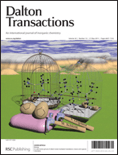
DALTON TRANSACTIONS
Connecting Minds in Inorganic ChemistryDALTON TRANSACTIONS, published by the esteemed Royal Society of Chemistry, is a premier journal in the field of Inorganic Chemistry, recognized for its significant contributions to advancing research and scholarship since its inception in 2002. With an impressive Impact Factor and ranked in the Q1 category, it holds a notable position at Rank #21 out of 79 within its Scopus category, highlighting its reputation for excellence and influence in the scientific community. This journal provides a platform for disseminating high-quality research, reviews, and communications related to all aspects of inorganic chemistry, fostering collaboration and innovation among researchers, professionals, and students alike. Although it does not offer open access, its robust selection process and commitment to scholarly integrity ensure that published works are of the highest standard. For those passionate about inorganic chemistry, DALTON TRANSACTIONS serves as an essential resource, fostering a deeper understanding of the field and its applications.
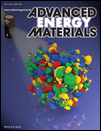
Advanced Energy Materials
Transforming Energy Research for a Sustainable TomorrowAdvanced Energy Materials is a leading academic journal published by WILEY-V C H VERLAG GMBH, focusing on the rapidly evolving fields of materials science and renewable energy technologies. With an impressive impact factor and recognition as a top-tier journal, it ranks within the Q1 category in both Materials Science (miscellaneous) and Renewable Energy, Sustainability and the Environment as of 2023. Spanning from 2011 to 2024, the journal serves as an essential platform for researchers, professionals, and students eager to explore groundbreaking advancements in energy materials, fostering innovative solutions to global sustainability challenges. The journal's authoritative content is supported by rigorous peer review, ensuring high-quality research contributes to the academic community and beyond. Located in Weinheim, Germany, Advanced Energy Materials stands at the forefront of scientific inquiry, making it an invaluable resource for those invested in the future of energy and materials science.

Aggregate
Elevating scientific discourse across disciplines.Aggregate, published by WILEY, is a premier open-access journal established in 2020, dedicated to advancing the fields of Chemistry, Materials Chemistry, Materials Science, and Molecular Biology. Based in the United States, this rapidly rising journal (Q1 in various categories as of 2023) has quickly made its mark as a valuable resource, evidenced by its impressive Scopus rankings—ranking #6 in Chemistry (miscellaneous) and #13 in Materials Science (miscellaneous) among others—place it firmly in the top percentiles of these disciplines. With an emphasis on rigorous peer-reviewed research, Aggregate provides an essential platform for researchers to disseminate groundbreaking findings and innovative methodologies that propel the scientific community forward. As an open-access journal, it ensures that cutting-edge research is accessible to a global audience, thereby enriching the dialogue among professionals, researchers, and students alike. Explore the latest advancements and contribute to the vibrant discourse in these critical areas of science by publishing with Aggregate.

ACS Applied Electronic Materials
Transforming Research into Real-World ApplicationsACS Applied Electronic Materials, published by the American Chemical Society, is a prominent journal in the field of applied materials science, with a particular focus on electronic, optical, and magnetic materials. Established in 2019, this journal has quickly risen to prominence, achieving a 2023 ranking of Q1 in both Electronic, Optical and Magnetic Materials and Materials Chemistry, as well as Q2 in Electrochemistry, reflective of its high-quality contributions and significant impact within the scholarly community. With an impressive Scopus rank of #22 in Electrochemistry, #59 in Electronic, Optical and Magnetic Materials, and #75 in Materials Chemistry, ACS Applied Electronic Materials serves as an essential resource for researchers, professionals, and students seeking to explore innovative advancements in the field. While the journal is not open access, it offers robust subscription options and aims to foster the dissemination of cutting-edge research articles, reviews, and technical notes that contribute to the understanding and application of electronic materials in various technological contexts. As a platform for pioneering research and cross-disciplinary dialogue, this journal is indispensable for anyone invested in the future of materials science.
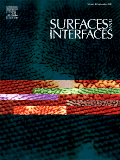
Surfaces and Interfaces
Advancing Knowledge at the Molecular InterfaceSurfaces and Interfaces is a leading international journal published by Elsevier, dedicated to advancing the understanding of surface and interfacial phenomena across various disciplines, including chemistry, materials science, and physics. With an impressive impact factor placing it in the Q1 quartile for its categories as of 2023—spanning Chemistry, Condensed Matter Physics, and Surfaces, Coatings, and Films—this journal not only serves as a critical platform for innovative research but also reflects the dynamic nature of surface science in contemporary applications. The journal is indexed in Scopus, ranking 25th out of 132 in the Materials Science – Surfaces, Coatings and Films category, marking it in the top 19% of this prestigious field. Although it is not an open-access platform, the journal remains a vital source of curated academic material for researchers, professionals, and students seeking to deepen their knowledge and contribute to ongoing conversations in surface and interface science. Published from the heart of Europe in Amsterdam, Surfaces and Interfaces invites submissions that challenge conventional paradigms and explore the forefront of technology and materials.

JOURNAL OF ELECTRONIC MATERIALS
Connecting Researchers to Groundbreaking Insights in ElectronicsWelcome to the Journal of Electronic Materials, a premier publication in the field of materials science. Published by Springer, this esteemed journal has been a beacon for groundbreaking research in electronic, optical, and magnetic materials since its inception in 1972. As an established resource, it boasts a commendable impact factor and categorically ranks in the second quartile (Q2) in key areas such as Condensed Matter Physics and Electrical and Electronic Engineering, as well as holding a respectable third quartile ranking in fields related to Electronic, Optical, and Magnetic Materials and Materials Chemistry. Researchers, professionals, and students can access a wealth of knowledge as we publish original articles, reviews, and cutting-edge research that push the boundaries of science and technology in these critical fields. Stay informed and engaged as we explore advancements that shape the future of electronic materials.
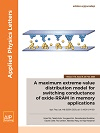
APPLIED PHYSICS LETTERS
Pioneering Research in Applied Physics Excellence.Applied Physics Letters, published by AIP Publishing, is a premier journal dedicated to the rapid dissemination of research in the dynamic field of applied physics. With an ISSN of 0003-6951 and an E-ISSN of 1077-3118, the journal has carved a niche for itself since its inception in 1962, serving as a vital forum for the exchange of innovative ideas and experimental findings. As of 2023, it proudly holds a Q1 ranking in the category of Physics and Astronomy (miscellaneous), standing at rank 11 out of 81 in Scopus, reflecting its influential role in advancing scientific knowledge with an impressive 87th percentile. The journal significantly contributes to the academic community by providing an accessible platform for both groundbreaking theoretical and applied research. Researchers and professionals alike benefit from its rigorous peer-review process and timely publication, fostering collaboration and dialogue among experts in the field. While the journal currently operates under a subscription model, its comprehensive scope encourages submissions covering all aspects of applied physics, making it an essential resource for researchers and students eager to stay at the forefront of this ever-evolving discipline.
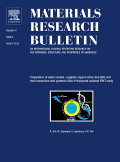
MATERIALS RESEARCH BULLETIN
Elevating research standards in materials science.MATERIALS RESEARCH BULLETIN is a prestigious journal published by Pergamon-Elsevier Science Ltd, dedicated to advancing the field of materials science and engineering. Since its inception in 1966, the journal has served as a platform for high-impact research, particularly in areas such as condensed matter physics, mechanical engineering, and materials mechanics. With an impressive Q1 ranking in multiple categories, including Condensed Matter Physics and Materials Science, MATERIALS RESEARCH BULLETIN stands out as a leading resource in its domain, aiming to disseminate innovative research findings and methodologies that address fundamental and applied aspects of materials. The journal’s rigorous peer-review process ensures the publication of high-quality articles, making it an essential resource for researchers, professionals, and students alike. With its ongoing commitment to fostering scientific discourse and collaboration, MATERIALS RESEARCH BULLETIN remains at the forefront of materials research, contributing significantly to the global scientific community.